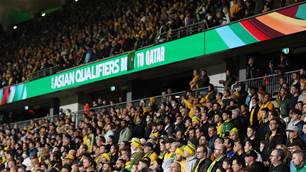A-LEAGUE clubs should follow Sydney FC's example and build closer ties with their W-League teams to boost their brand and improve Australian football, says Championship-winning coach Alen Stajcic.
Sunday’s Grand Final attracted unprecedented media attention after what was widely regarded as the best season yet for the women's elite eight team competition.
A vocal and colourful 4181-strong crowd almost broke attendance records when they turned up to watch the Sky Blues down Melbourne 3-1 in an enthralling encounter at AAMI Park.
Senior board members and management from the A-League clubs were in the stands and both Stajcic and Melbourne coach Fabrizio Soncin said closer ties between the men and women’s leagues was a win-win for football.
“A-League clubs need to recognise that women’s football is a living, walking billboard for their brand,” Soncin said.
“They need to look at the women’s game as an investment and a promotion – not just for the women’s game but for the club itself.
“Rather than putting posters all over the place, this is the best form of advertising.
“In Spain for instance you have the big clubs like Barcelona and Real Madrid who also own professional basketball clubs. Same logo, same brand.
“I think in that way it’s a win-win situation. It promotes the club brand but it also benefits the women’s game by investing more money so it can become more professional and better run.”
Melbourne’s W-League team is run by Football Federation Victoria but in Sydney the women’s team has reaped the rewards of close ties with the Sky Blues who took control of the outfit from the NSW Institute of Sport.
This season the team had five major sponsors – a crucial ingredient in the plan to turn their young squad into a championship-winning dynasty.
“They’ve really embraced the team in the last couple of years especially this year and given us a lot more resources and a lot more help in running the team,” Stajcic said.
“A lot of W-League clubs are run by state federations so they don’t really have an affiliation with the A-League club at all.
“Sydney has taken a different tact and I’m really happy that they have because the more resources and help we get the stronger our team is going to be in the future.”
The title-winning coach said he could understand the resistance from a financial point of view.
“Some A-League club owners possibly see it as a burden, having to run an extra team and all the finances and all the resources that go with it.
“But I’m pretty sure Sydney FC don’t think like that. They embrace the team and think of all the benefits attached to it such as engaging a wider audience, all the extra exposure they get from having that extra team that represents their club.”
Soncin who has been involved in men’s football for most of his life admits it’s a new way of looking at the game even for him.
But he said the potential for the A-League and the W-League through greater synergies was enormous. And he was particularly keen to see the women’s game connect more with the grassroots.
As head coach for one of Victoria’s summer league zones he invited junior representative teams to attend Melbourne’s training sessions and was astonished by the reaction.
“We did a lot this year to try and promote the game to our juniors,” Soncin said. “It was never done before – but I thought it makes sense and it surprised me that the response was immediate.
“Coaches were booking in training sessions to come along and watch. For about three weeks we had between 60 and 100 young players coming to watch.
“It was good because one, it exposed the game to young girls - they got to meet the players. And for the players it was good because they were treated like stars. They were signing autographs.
“I always look at the big picture. It’s not just about a win now – I look at making the maximum impact we can and I think we did that.
“We had so many young girls at our training sessions. We had the grand final here at Melbourne and we promoted it as best we could – not just for the women’s game but for the Melbourne Victory brand.”
Related Articles

Last Socceroos World Cup home qualifier location confirmed

Canberra hoping for 2022 Matildas matches













